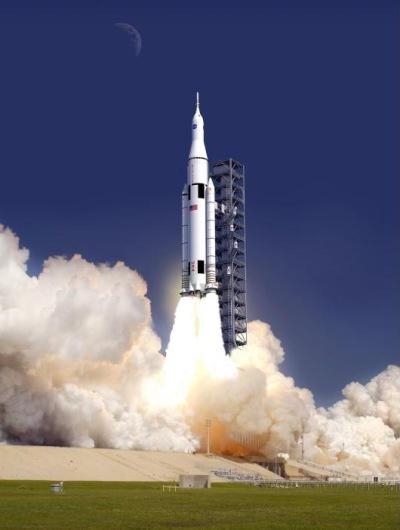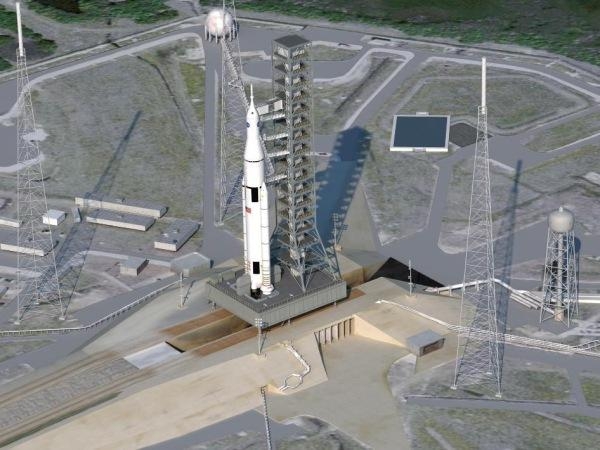New Heavy-Lift Rocket Will Take Humans Far Beyond Earth
NASA has selected the design of a new Space Launch System that
it says will take the agency's astronauts farther into
space than ever before, create high-quality jobs here at home, and
provide the cornerstone for America's future human space
exploration efforts.
NASA SLS Artist's Concept

This new heavy-lift rocket-in combination with a crew capsule
already under development, increased support for the
commercialization of astronaut travel to low Earth orbit, an
extension of activities on the International Space Station until at
least 2020, and a fresh focus on new technologies-is key to
implementing the plan laid out by President Obama and Congress in
the bipartisan 2010 NASA Authorization Act, which the president
signed last year. The booster will be America's most powerful since
the Saturn V rocket that carried Apollo astronauts to the moon and
will launch humans to places no one has gone before.
"This launch system will create good-paying American jobs,
ensure continued U.S. leadership in space, and inspire millions
around the world," NASA Administrator Charles Bolden said.
"President Obama challenged us to be bold and dream big, and that's
exactly what we are doing at NASA. While I was proud to fly on the
space shuttle, tomorrow's explorers will now dream of one day
walking on Mars."
This launch vehicle decision is the culmination of a
months-long, comprehensive review of potential designs to ensure
the nation gets a rocket that is not only powerful but also
evolvable so it can be adapted to different missions as
opportunities arise and new technologies are developed. "Having
settled on a new and powerful heavy-lift launch architecture, NASA
can now move ahead with building that rocket and the
next-generation vehicles and technologies needed for an ambitious
program of crewed missions in deep space," said John P. Holdren,
assistant to the President for Science and Technology. "I'm excited
about NASA's new path forward and about its promise for continuing
American leadership in human space exploration."
NASA SLS Artist's Concept

The SLS will carry human crews beyond low Earth orbit in a
capsule named the Orion Multi-Purpose Crew Vehicle. The rocket will
use a liquid hydrogen and liquid oxygen fuel system, where RS-25D/E
engines will provide the core propulsion and the J2X engine is
planned for use in the upper stage. There will be a competition to
develop the boosters based on performance requirements.
The decision to go with the same fuel system for the core and
the upper stage was based on a NASA analysis demonstrating that use
of common components can reduce costs and increase flexibility. The
heavy-lift rocket's early flights will be capable of lifting 70-100
metric tons before evolving to a lift capacity of 130 metric tons.
The early developmental flights may take advantage of existing
solid boosters and other existing hardware. These flights will
enable NASA to reduce developmental risk, drive innovation within
the agency and private industry, and accomplish early exploration
objectives.
"NASA has been making steady progress toward realizing the
president's goal of deep space exploration, while doing so in a
more affordable way," NASA Deputy Administrator Lori Garver said.
"We have been driving down the costs on the Space Launch System and
Orion contracts by adopting new ways of doing business and project
hundreds of millions of dollars of savings each year."
NASA elected to initiate a competition for the booster stage
based on performance parameters rather than on the type of
propellant because of the need for flexibility. The specific
acquisition strategy for procuring the core stage, booster stage,
and upper stage is being developed and will be announced at a later
time.
 ANN's Daily Aero-Linx (04.16.24)
ANN's Daily Aero-Linx (04.16.24) Aero-News: Quote of the Day (04.16.24)
Aero-News: Quote of the Day (04.16.24) Airborne 04.10.24: SnF24!, A50 Heritage Reveal, HeliCycle!, Montaer MC-01
Airborne 04.10.24: SnF24!, A50 Heritage Reveal, HeliCycle!, Montaer MC-01 Airborne 04.12.24: SnF24!, G100UL Is Here, Holy Micro, Plane Tags
Airborne 04.12.24: SnF24!, G100UL Is Here, Holy Micro, Plane Tags Airborne-Flight Training 04.17.24: Feds Need Controllers, Spirit Delay, Redbird
Airborne-Flight Training 04.17.24: Feds Need Controllers, Spirit Delay, Redbird




